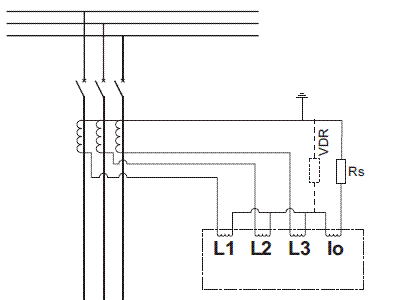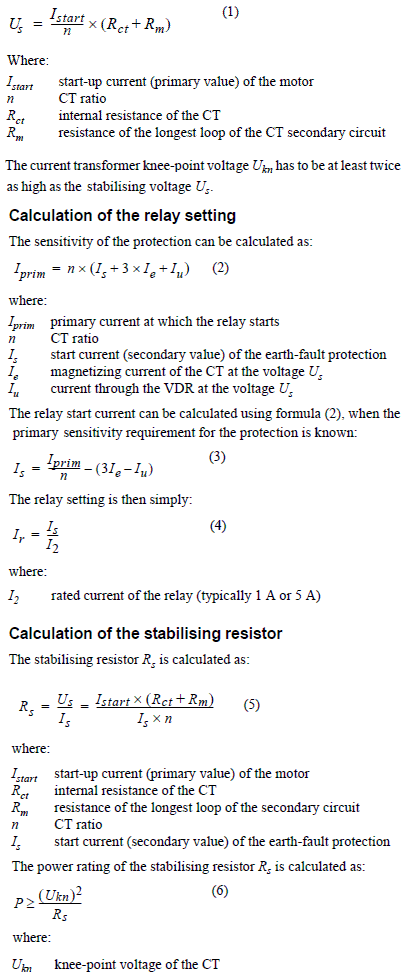The magnitude and duration of magnetizing inrush currents of transformers vary between different designs. Inrush currents of 8 or 12 times normal full-load current for 0.1 s are commonly used in coordination studies. Therefore the maximum continuous-current rating should be equal to or greater than the rating of the circuit in which the CT is used. The magnitude of inrush current should also be considered, particularly with respect to its effect upon meters, relays, and other connected devices. For example, a 600:5 CT would be recommended for use on a circuit with a full-load current of 400 A. The selectivity of residually connected relays is determined by the CT ratio and the relay pickup setting. The CT ratio must be high enough for normal load circuits. Also to be considered are the unbalanced primary currents in each phase, the sum of which may contain sufficient asymmetrical current to cause a trip during a motor start. For this reason, sensitive ground-fault protection schemes do not use instantaneous trips when a residually connected circuit is involved. If ground-fault protection with greater sensitivity is needed, the core-balance method should be considered. The main rule of transformer standby ground fault protection is back up protection, so the instantaneous low set earth fault protection is not applicable in this case. For some useful consideration to ground fault setting refer to some Schneider recommendation as below.  However ABB have some recommendation when we persist to application of low set earth fault protection in power system with high starting current. As ABB stated (1MRS 755627), the stabilizing resistor may be useful against huge starting current when the residual connection of the three phase CTs is used. Generally this connection is also called the Holmgreen connection. The residual connection can be used when the sensitivity requirement is about 10% of the CT nominal current, or higher. In this case an unwanted operation of the earth-fault protection relay sometimes occurs during motor or transformer start-up. The reason for the unwanted relay operation may be that the start-up current occasionally causes one or more of the three phase CTs in residual connection to saturate. The CT saturation is caused by the DC component of the unsymmetrical start-up current. To avoid this problem a suitable stabilizing resistor can be connected in series with the earth-fault current input of the protection relay. The stabilizing resistor forces the current fed by a non-saturated current transformer to flow through the secondary circuit of a saturated current transformer. Figure below illustrates the connection principle when the earth-fault current is measured through the residual connection of the three phase CTs. The stabilizing resistor is connected in series with the earth-fault current input of the protection relay. The purpose of the voltage-dependent resistor is to limit the voltage of the secondary circuit to a safe level. The need for a VDR is case-specific and can be checked by calculation.
However ABB have some recommendation when we persist to application of low set earth fault protection in power system with high starting current. As ABB stated (1MRS 755627), the stabilizing resistor may be useful against huge starting current when the residual connection of the three phase CTs is used. Generally this connection is also called the Holmgreen connection. The residual connection can be used when the sensitivity requirement is about 10% of the CT nominal current, or higher. In this case an unwanted operation of the earth-fault protection relay sometimes occurs during motor or transformer start-up. The reason for the unwanted relay operation may be that the start-up current occasionally causes one or more of the three phase CTs in residual connection to saturate. The CT saturation is caused by the DC component of the unsymmetrical start-up current. To avoid this problem a suitable stabilizing resistor can be connected in series with the earth-fault current input of the protection relay. The stabilizing resistor forces the current fed by a non-saturated current transformer to flow through the secondary circuit of a saturated current transformer. Figure below illustrates the connection principle when the earth-fault current is measured through the residual connection of the three phase CTs. The stabilizing resistor is connected in series with the earth-fault current input of the protection relay. The purpose of the voltage-dependent resistor is to limit the voltage of the secondary circuit to a safe level. The need for a VDR is case-specific and can be checked by calculation.  Calculation of stabilizing voltage The stabilizing voltage Us is calculated assuming that one of the residually connected current transformers will be fully saturated at motor start-up:
Calculation of stabilizing voltage The stabilizing voltage Us is calculated assuming that one of the residually connected current transformers will be fully saturated at motor start-up: 
